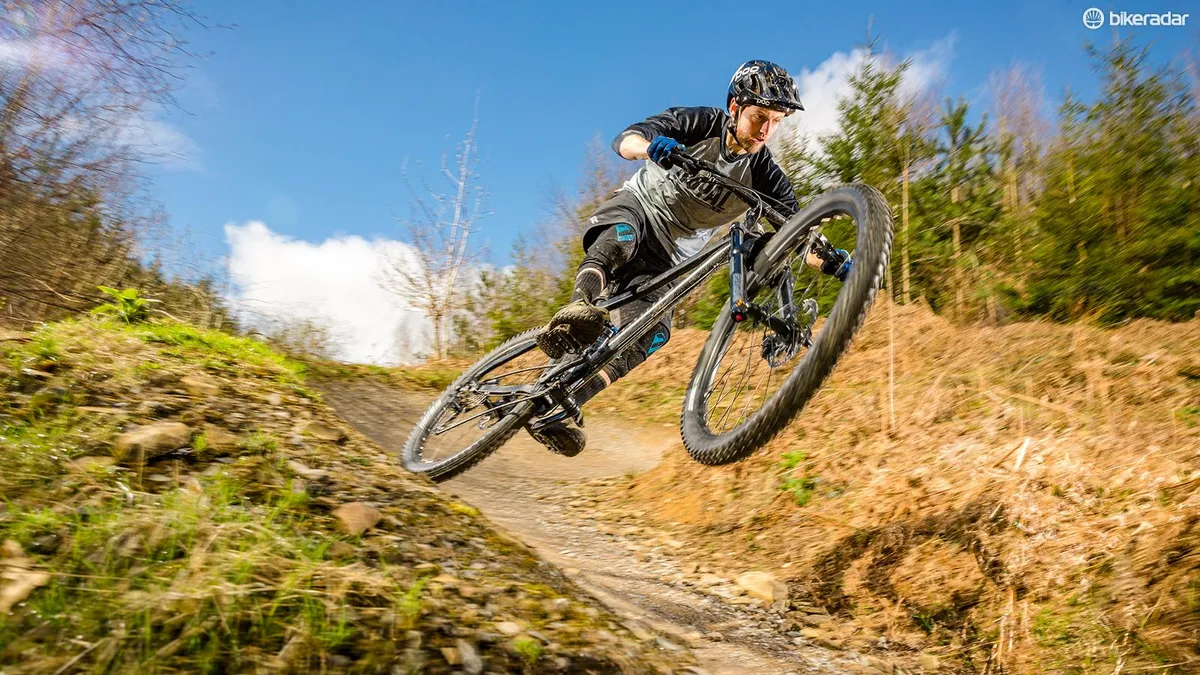VooDoo’s four-bar linkage bikes have been strong contenders in the sub-£1,000 suspension field, but can the Canzo compete with the latest four-figure full-sussers?
The chassis has a proper metal head badge on its tapered head tube. Its main tubes are double-butted and hydroformed, and the seat tube has an S-bend moulded into it to support the rocker link that drives the rear shock. That means you can’t drop the seatpost far into the frame, so you’ll need to upgrade to a dropper if you want to move your body weight around significantly on descents.
The back end is from the ‘simple but reasonably effective’ school of design. Single-sided pivots at the end of square chainstays combine with the rocker link to create a four-bar linkage. This moves the rear wheel in a curve plotted by the designer, rather than just arcing it round like the Jamis’s single-pivot swingarm.
While it’s disappointing to see QR dropouts, they’re the new 141mm ‘Boost Open’ width, not the traditional 135mm. This doesn’t translate to any significant gains in clearance, because the seatstays have a brace above the tyre.
Cables are routed externally (though there is provision for a semi-internal dropper) and a single bottle mount is provided. The Suntour DuAir rear shock gets a ‘lockout’ switch to stiffen it up, and its rebound damping is adjustable too.
VooDoo Canzo kit

Suntour also makes the Raidon fork, which has 34mm upper legs (rather than the normal 32 or even 30mm at this price) and a Boost-width through-axle. Its Zeron single-ring cranks use an alternating ‘ZIGZAG’ tooth profile to hold the chain in place, aided by the switchable clutch on the Shimano Deore rear mech.
The cockpit is impressively up to date too, with a short 45mm stem holding a 760mm bar fitted with lock-on grips. Sadly, the Kenda tyres aren’t such a win, with a plasticky, slippery feel on damp surfaces.
VooDoo Canzo ride impressions
With its contemporary cockpit, 67-degree head angle and 140mm of travel, the Canzo looks good on paper. Sadly, it doesn’t live up to that promise on the trail. The main culprit is the fork.
While the larger legs make it stiffer, they also mean more seal drag, so it takes a significant impact to get it moving, and the negative spring which should help offset that stickiness is too weak.
It clatters and spikes over anything more than a small stick, and riding trails that are even remotely rocky is a punishing experience. You can make it more fluid by reducing the air pressure until you see the negative spring suddenly pull the fork into its travel. But that leaves it so soft that it plunges through its stroke over the slightest lump, or even when braking or pedalling out of the saddle.

In contrast, the rear shock is pretty smooth over small bumps. This means the whole-bike balance is out of kilter, with the front riding stubbornly high and the back sagging down, effectively rotating the ride axis of the bike around the bottom bracket. This keeps the bar way up high, reducing the effective reach, and gives a perched and unwieldy feel.
The rear end sucks up smaller bumps to maintain momentum without bouncing too badly. That’s a good job, because the ‘lockout’ is so bad it actually made me laugh as I pogoed uphill (it switches off the rebound damping, so the shock fires back with a savage bounce). The skinny shock link and single-sided pivots mean noticeable twist and twang through the back end when you’re stomping the power down, too.
While the Clarks brakes feel wooden, even compared to the cheapest Shimano M300-series stoppers, they do improve noticeably if you upgrade the pads, and are massively reliable. You’re unlikely to wear out the tyres for years either and they roll okay considering how knobbly they look. But if you’re wanting a combat-ready trail bike rather than a lookalike cruiser/commuter, you’ll need a new fork, better tyres and a dropper post.

